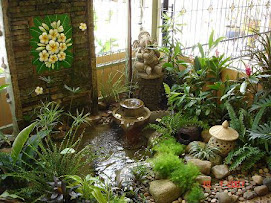Mediterranean bulbs and dry gardens
The owners of Le Domaine aux Quat'Saisons (A Jewel in the Languedoc - France Magazine) now let you into some of the secrets of their success in creating a oasis of colour throughout the year in a dry Mediterranean climate. ……………………………………………….. In all regions of the world where rainfall is low or unreliable and summer temperatures high mediterranean gardening, most of the plants that are adapted to these conditions produce little or no flowers, or at best a quick burst of flowers in spring. Summer displays can be dull and dried-out and temperate garden plants that normally flower in spring will not survive the summers. The Languedoc is no exception to this; after the flush of spring flowers, gardens are brown and dry by the end of June, with colour returning only after the rains in early autumn. Bedding plants are all thirsty by nature and few of us can afford the water and time they need. At Le Domaine aux Quat'Saisons one of the best ways we have found to counteract these problems is to introduce bulbs and corms; many of these will flower spectacularly for years and years, increasing gradually and requiring little or no extra water. The greatest variety of species is available in spring but summer bulbs are certainly an essential addition to the garden to introduce much-needed colour.No spring dry garden can be considered complete without at least some alliums. There are hundreds of species. These are our favourites: A. cristophii ((8in purple-pink spherical flower heads on 2ft high stems), A. hollandicum 'Purple Sensation' (4-5in lilac-mauve spherical flower heads on 3ft high stems)' A. 'Globemaster' (6-8in purple spherical flower heads on 2 1/2ft high stems), A. moly (small yellow flowers) and A. schubertii (1ft diameter lilac heads, with fantastic pedicels of different lengths).Bearded (or common) irises are exceptionally drought tolerant and their rhizomes enjoy a good baking in the summer; with so many varieties and colours to chose from no dry garden can be without some of these. They are virtually maintenance free, apart from dividing the clumps when they get too overcrowded.We also are big fans of species tulips; these have near-perfect jewel like flowers and will increase gradually by seed and through vegetative growth. These bulbs come from regions where there are hot dry summers. Tulipa (dasystemon) tarda sometimes even has five flowers on a single stem, white with a bright yellow base. They flower abundantly for a long time and are very easy to grow and are native to Turkestan in Central Asia. Tulipa linifolia is dwarf species native to Bokhara and the Pamir mountain range in Asia; brilliant scarlet flowers with a black base. T. greiggii from Turkestan, Kazakhstan, Kyrgyzstan and Uzbekistan is also suitable as are the hybrids produced from it (such as the Greiggii tulip 'Red Riding Hood')/The corner stone of colourful summer gardens in a dry, hot climate are Agapanthus. These offer the most striking blue or white flowers (we prefer the blue forms) contrasted with strap like green foliage. There is also Canna indica, the many hybrids of which offer stunning red, yellow or orange flowers all through the summer. Agapanthus can tolerate no additional water and will grow in full sun or part shade and also make an excellent candidate for large pots, but Cannas do appreciate an occasional watering. We have also had great success with Tulbaghia violacea, a member of the allium family; it will flower for months with no water in the summer. Its purple, chive-like flowers and green lush evergreen foliage make it an excellent edging plant.Another plant that succeeds admirably in this environment in the summer is Mirabilis jalapa (marvel of Peru). It has a tuberous tap-root and flowers continually with small red, pink or white highly perfumed flowers throughout out high summer and will tolerate almost no water. It readily self seeds and will come up all over the garden once established. Similarly Crocosmias will flower with little or no water. Crocosmias produce dense clumps of upright iris-like foliage. In midsummer this makes a good background for the small, profuse flowers. We especially like 'Lucifer' with paprika red flowers.Extending the summer into autumn can be an especially difficult period in the dry garden if there is little rain. Nerine bowdenii has shocking pink lily like flowers and performs well in dry conditions. A native to South Africa the bulbs, do not tolerate cold winter temperatures, especially if wet.Another pair of autumn successes are Cyclamen neapolitanum and Sternbergia lutea. C. neapolitanum likes partial shade and has pretty pink or white flowers and attractive marbled foliage. S. lutea has vivid yellow crocus like flowers and spread rapidly to form good sized clumps.In winter we find that Cyclamen coum and Iris foetidissima perform well. The pods of I. foetidissima peel open to reveal a profusion of vibrant orange seeds and look beautiful next to the apple green flowers of Helleborus argutifolius. Iris unguicularis is another exceptionally drought tolerant iris; it produces wonderful blue/yellow flowers from December to February, another essential for the winter dry garden. Its strap like leaves can look a little messy but its lovely flowers more than compensate.Nariccus tazzetta hybrids (for example 'Ehrlicher') originate from the Mediterranean region and flower in January/February. They need little or no water and the flowers are highly scented. To find out more about our garden and its collection of flowering bulbs, please contact us as below.Hotel Le Domaine aux Quat'Saisonsbed and breakfast carcassonnesouth of france hotel00 33 (0) 4 68 244 973
About the author:
a keen gardener fior more than 30 years, seb Marquet advises you what bulbs to plant for success in dry Mediterranean gardens.
Article Source: http://www.Free-Articles-Zone.com



No comments:
Post a Comment